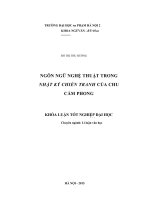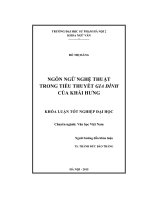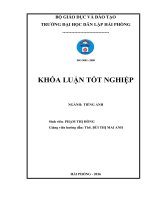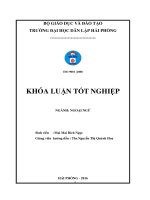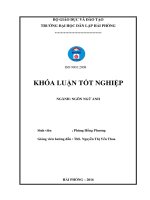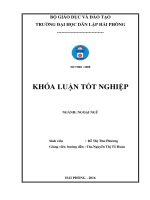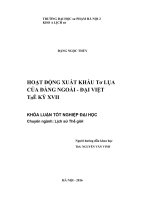Khóa luận tốt nghiệp ngoại ngữ metaphors relating to the names of animals in english and vietnamese
Bạn đang xem bản rút gọn của tài liệu. Xem và tải ngay bản đầy đủ của tài liệu tại đây (344.75 KB, 65 trang )
BỘ GIÁO DỤC VÀ ĐÀO TẠO
TRƯỜNG ĐẠI HỌC DÂN LẬP HẢI PHÒNG
-------------------------------
ISO 9001:2008
KHÓA LUẬN TỐT NGHIỆP
NGÀNH: NGÔN NGỮ ANH
Sinh viên
: Phùng Hồng Phương
Giảng viên hướng dẫn : ThS. Nguyễn Thị Yến Thoa
HẢI PHÒNG – 2016
BỘ GIÁO DỤC VÀ ĐÀO TẠO
TRƯỜNG ĐẠI HỌC DÂN LẬP HẢI PHÒNG
-----------------------------------
METAPHORS RELATING TO THE NAMES OF
ANIMALS IN ENGLISH AND VIETNAMESE
KHÓA LUẬN TỐT NGHIỆP ĐẠI HỌC HỆ CHÍNH QUY
NGÀNH: NGÔN NGỮ ANH
Sinh viên
: Phùng Hồng Phương
Lớp
: NA1601
Giảng viên hướng dẫn
: Th.S Nguyễn Thị Yến Thoa
HẢI PHÒNG – 2016
BỘ GIÁO DỤC VÀ ĐÀO TẠO
TRƯỜNG ĐẠI HỌC DÂN LẬP HẢI PHÒNG
--------------------------------------
NHIỆM VỤ ĐỀ TÀI TỐT NGHIỆP
Sinh viên: ………………………………………Mã SV: ………………
Lớp: …………………... Ngành: ………………………………………….
Tên đề tài: ………………………………………………………………….
……………………………………………………………………………….
……………………………………………………………………………….
……………………………………………………………………………….
……………………………………………………………………………….
NHIỆM VỤ ĐỀ TÀI
1.
Nội dung và các yêu cầu cần giải quyết trong nhiệm vụ đề tài
tốt nghiệp (về lý luận, thực tiễn, các số liệu cần tính toán và các bản
vẽ).
……………………………………………………………………………….
……………………………………………………………………………….
……………………………………………………………………………….
……………………………………………………………………………….
……………………………………………………………………………….
……………………………………………………………………………….
2.
Các số liệu cần thiết để thiết kế, tính toán.
……………………………………………………………………………….
……………………………………………………………………………….
……………………………………………………………………………….
……………………………………………………………………………….
……………………………………………………………………………….
3.
Địa điểm thực tập tốt nghiệp.
……………………………………………………………………………….
……………………………………………………………………………….
……………………………………………………………………………….
……………………………………………………………………………….
CÁN BỘ HƯỚNG DẪN ĐỀ TÀI TỐT NGHIỆP
Người hướng dẫn thứ nhất:
Họ và tên: ………………………………………………………………….
Học hàm, học vị: …………………………………………………………..
Cơ quan công tác: …………………………………………………………
Nội dung hướng dẫn: ……………………………………………………..
Người hướng dẫn thứ hai:
Họ và tên: ………………………………………………………………….
Học hàm, học vị: …………………………………………………………..
Cơ quan công tác: …………………………………………………………
Nội dung hướng dẫn: ……………………………………………………..
Đề tài tốt nghiệp được giao ngày … tháng … năm … …
Yêu cầu phải hoàn thành xong trước ngày … tháng … năm … …
Đã nhận nhiệm vụ ĐTTN
Đã giao nhiệm vụ ĐTTN
Sinh viên
Người hướng dẫn
Hải Phòng, ngày … tháng … .năm … …
Hiệu trưởng
GS.TS.NGƯT Trần Hữu Nghị
PHẦN NHẬN XÉT CỦA CÁN BỘ HƯỚNG DẪN
1.
Tinh thần thái độ của sinh viên trong quá trình làm đề tài tốt
nghiệp:
……………………………………………………………………………….
……………………………………………………………………………….
……………………………………………………………………………….
……………………………………………………………………………….
……………………………………………………………………………….
2.
Đánh giá chất lượng của khóa luận (so với nội dung yêu cầu đã
đề ra trong nhiệm vụ Đ.T. T.N trên các mặt lý luận, thực tiễn,
tính toán số liệu…):
……………………………………………………………………………….
……………………………………………………………………………….
……………………………………………………………………………….
……………………………………………………………………………….
……………………………………………………………………………….
3.
Cho điểm của cán bộ hướng dẫn (ghi bằng cả số và chữ):
……………………………………………………………………………….
……………………………………………………………………………….
……………………………………………………………………………….
Hải Phòng, ngày … tháng … năm 2016
Cán bộ hướng dẫn
(Ký và ghi rõ họ tên)
NHẬN XÉT ĐÁNH GIÁ CỦA NGƯỜI CHẤM PHẢN
BIỆN ĐỀ TÀI TỐT NGHIỆP
1.
Đánh giá chất lượng đề tài tốt nghiệp về các mặt thu thập và
phân tích tài liệu, số liệu ban đầu, giá trị lí luận và thực tiễn
của đề tài.
……………………………………………………………………………….
……………………………………………………………………………….
……………………………………………………………………………….
……………………………………………………………………………….
……………………………………………………………………………….
……………………………………………………………………………….
2.
Cho điểm của người chấm phản biện:
……………………………………………………………………………….
……………………………………………………………………………….
……………………………………………………………………………….
……………………………………………………………………………….
……………………………………………………………………………….
(Điểm ghi bằng số và chữ)
Ngày………. tháng……… năm 2016
Người chấm phản biện
(Ký và ghi rõ họ tên)
TABLE OF CONTENTS
Acknowledgements
PART 1: INTRODUCTION........................................................................ 1
1. Rationale ................................................................................................... 1
2. Aims of the study ...................................................................................... 1
3. Scope of the study ..................................................................................... 1
4. Methods of the study ................................................................................. 2
5. Design of the study .................................................................................... 2
PART II: DEVELOPMENT ....................................................................... 3
Chapter 1: Literature Review
1.1. Overview of semantic change .............................................................. 3
1.1.1..............................................................................................................
Definition of semantic change ........................................................... 3
1.1.2..............................................................................................................
Types of figures of speech ................................................................. 3
1.2.
Overview of metaphor ...................................................................... 4
1.2.1. Definition of metaphor ..................................................................... 4
1.2.2. Types of metaphors .......................................................................... 4
1.2.3. Sources of metaphors ....................................................................... 6
Chapter 2: Metaphors relating to the names of animals in English
2.1. Metaphors relating to the name of Dog ............................................... 10
2.2. Metaphors relating to the name of Cat ................................................. 15
2.3. Metaphors relating to the name of Cow ............................................... 18
2.4. Metaphors relating to the name of Bird ............................................... 21
2.5. Metaphors relating to the name of Chicken ......................................... 23
2.6. Metaphors relating to the name of Lion ............................................... 25
2.7. Metaphors relating to the name of Snake ............................................. 27
2.8. Metaphors relating to the name of Fox ................................................ 29
2.9. Metaphors relating to the name of Wolf .............................................. 30
2.10. .......................................................................................................Met
aphors relating to the name of Rat ...................................................... 32
2.11. .......................................................................................................Met
aphors relating to the name of Monkey ............................................... 34
2.12. .......................................................................................................Met
aphors relating to the name of Pig ...................................................... 36
Chapter 3: Application of the study
3.1. ............................................................................................................ S
ome comparisons between metaphors relating to the names of animals in
English and Vietnamese ...................................................................... 40
3.1.1. ...................................................................................................... S
ome similarities between metaphors relating to the names of animals
in English and Vietnamese ............................................................. 40
3.1.2. ...................................................................................................... S
ome distinctions between metaphors relating to the names of animals
in English and Vietnamese ............................................................. 41
3.2. ............................................................................................................ S
ome difficulties and suggestions when learning English metaphors
relating to the names of animals .......................................................... 43
3.2.1. ...................................................................................................... S
ome difficulties when learning English metaphors relating to the
names of animals ........................................................................... 43
3.2.2. ...................................................................................................... S
ome suggestions for English learners when learning English
metaphors relating to the names of animals ................................... 44
3.3. ............................................................................................................ S
ome exercises in metaphors relating to the names of animals .............. 44
PART III: CONCLUSION ........................................................................ 50
1................................................................................................................ S
ummary .................................................................................................. 50
2................................................................................................................ Id
eas for further study ............................................................................... 50
References ................................................................................................. 51
Appendix .................................................................................................... 52
ACKNOWLEDGEMENTS
To fulfil my graduation paper, I get great favours from my teachers,
family and friends to whom I am truly grateful.
First of all, I sincerely thank my supervisor, Ms Nguyen Thi Yen Thoa,
M.A for her precious guidance and recommendation to me during the time I
did the research.
I am also grateful to all teachers and staffs from Haiphong Private
University, especially Foreign Language Department. They offered me not
only book learning but also useful life lessons with lots of dedication and
enthusiasm.
Besides, my heartfelt thanks will be sent to my mom and my friends who
inspired, encouraged and supported me to follow my dream to become a
graduate in English.
It is said that enough is not enough when it comes to gratitude, then I just
try my best and do not make all of them disappointed about me. However, my
knowledge and time in the process of completion are limited so I cannot avoid
some mistakes which need to be pointed out and corrected. I certainly hope to
receive useful advice from teachers and readers to make my paper as good as
possible. Thank you very much!
Student
Phùng Hồng Phương
PART I: INTRODUCTION
1.
Rationale
Nowadays, English is an extremely common language with millions of
native speakers and over one billion people using as second language or foreign
language, (Crystal, 2006). People use English for communication, trade
exchanges, study, travel, so on and the Vietnamese are not exceptions. However,
although teaching and learning English in Vietnam have been improved by
years, it is never an easy language to read and understand because of many
reasons. One of those is the ambiguity which caused by the transference of word
meaning, especially metaphor.
Firstly, the Vietnamese and English, like many other languages, use
metaphor, but its meaning is distinctly different. Therefore, if we do not study
English profoundly, we may be confused and misunderstand English metaphor.
Secondly, in Haiphong Private University, metaphor is primarily learned
through one lecture of Lexicology. There is not enough time to research all
aspects of metaphor.
Metaphor relating to the names of the animals is an interesting topic that
helps us not only understand clearly about English texts but also English culture
and lifestyle. This is the reason why I choose the study of metaphors relating to
the names of the animals for my graduation paper.
2.
Aims of the study
The study will focus on metaphors relating to the names of some certain
animals to find out what names of the animals English people use as metaphors
and how they use them in both texts and speeches.
3.
Scope of study
Metaphors relating to the names of the animals are so large that my
1
graduation paper cannot cover all of their aspects and objects. Therefore, I will
focus on analysing metaphorical sense of several common animals’ name which
the English often use as metaphorical meaning.
4.
Methods of the study
In order to understand metaphors relating to the names of the animals in
English and Vietnamese, the methods are shown below:
Materials analysis: I will read different reference books to collect
necessary information and analyze them to contribute to the study.
Exercise compilation: I will also compile some interesting exercises for
English major students to read and study profoundly about metaphor.
5.
Design of the study
The study is divided into three parts:
Part I: Introduction: In the first part, I will present the rationale, aims,
methods, scope and design of the study.
Part II: Development: This part consists of three chapters:
Chapter 1: Literature background: The first chapter provides definition of
metaphor and its characteristics.
Chapter 2: Metaphors relating to the names of animals in English and
Vietnamese: This chapter focuses on analysing twelve common animals’
name that English people often use as metaphorical meaning.
Chapter 3: Application of the study: The chapter provides some
comparisons between metaphors relating to the names of animals in English
and Vietnamese, some difficulties when learning English metaphors relating
to the names of animals, some solutions to them and exercises in metaphors.
Part III: Conclusion: In conclusion, I will summarise briefly the main
points of the study and draw some ideas for further research.
2
PART II: DEVELOPMENT
CHAPTER 1: LITERATURE REVIEW
1.1.
Overview of semantic change
1.1.1.
Definition of semantic change
Semantic change is thought to be an important ways to help language
more flexible and prosperous. It is necessary to start the study by learning some
basic concepts of semantic change and then detailing metaphor and metaphors
relating to the names of animals in particular.
According to Bloomfield(3) semantic change is defined as the innovations
changing the meaning of words rather than grammatical function forms. Hence,
meaning of the new word is often different from meaning of the original words.
He gave an example the word “bite” whose meaning is “harsh of taste” instead
of an action using your teeth to cut into or through something. However,
Bloomfield also saw that in some cases of semantic change, word properties
may be related to its connotations like the words understand, forgive, forget,
overcome, so on.
1.1.2.
Type of semantic change
Until now, some classification schemes for semantic change have been
suggested, of those, the most widely accepted scheme is proposed by Bloomfield
(1933). His scheme includes: Narrowing, Widening, Metaphor, Metonymy,
Synecdoche, Hyperbole, Meiosis, Degeneration and Elevation.
Besides, we also accept the categorisation of Blank (1999) which consists
of Metaphor, Metonymy, Synecdoche, Specialization of meaning, Generalization
of meaning, Cohyponymic transfer, Antiphrasis, Auto-antonymy, Auto-converse,
Ellipsis and Folk-etymology.
In brief, irrespective of semantic change is categorised according to
Bloomfield or Blank, metaphor is always a common types of semantic change
3
and play roles in the development of language.
1.2.
Overview of metaphor
1.2.1.
Definition of metaphor
According the Oxford advanced learner's dictionary, metaphor is “a word
or phrase used to describe somebody or something else, in a way that is
different from its normal use, in order to show that the two things have the
same qualities and to make the description more powerful”. (Hornby: 965)(4)
In cognitive linguistic view, according to Barcelona(2), metaphor is
defined as the cognitive mechanism whereby one experiential domain is
partially mapped or projected onto a different experiential domain so that the
second one is partially understood in terms of the first one.
Some linguists suppose that metaphor plays important roles not only in
the literature, but also in the cognition. Indeed, in the book “Metaphors We
Live By”, George Lakoff and Mark Johnson(6) saw metaphors are pervasive in
everyday life in language, thought and action as well. However, the study
merely considers metaphor as a figure of speech and researches some typical
animals’ names used for metaphor.
1.2.2.
Types of metaphors
Basically, English metaphors are classified into three types: Living
metaphor, Faded metaphor and Dead metaphor.
a)
Living metaphor
Living metaphor, also known as extended metaphor, is the case in which
the word has unusual metaphorical sense or used by an individual. It is often
used in both poetry and prose and makes them more interesting, imaginative and
elegant.
But soft! What light through yonder window breaks?
It is the East, and Juliet is the sun!
4
Arise, fair sun, and kill the envious moon,
Who is already sick and pale with grief
(Shakespeare’s Romeo and Juliet)
Here, Shakespeare compared Juliet with the sun to praise her beauty and
brilliance. At the same time, he also compared a person who is grievously sick
and pale with the envious moon killed by the sun. Thus, we are able to imagine
how beautiful Juliet is! Living metaphor is an indispensable figure of speech that
poets and authors would like to use.
b)
Faded metaphor
Faded metaphor is the case in which the word loses its freshness due to
long and traditional use. If living metaphors are individually used and
sometimes they made us easily confused, faded metaphors are exclusively
accepted by contrast.
He was so exhausted that he fell asleep at his desk.
(Hornby:75)(4)
Of course, “fall asleep” (past simple “fell”) is not used with literal
meaning: to drop out. It means you start sleeping instead. If “go to sleep” means
you start sleeping deliberately, “get to sleep” means you start sleeping
difficultly, “fall asleep” usually means you start sleeping incidentally or in an
inappropriate situation like the example Hornby provided, sleeping at the desk.
Faded metaphor is closely related to lexical ambiguity and polysemy.
Besides, almost metaphors relating to the names of the animals are faded
metaphors and they are studied at length in chapter two.
c)
Dead metaphor
Dead metaphor is the case in which the word has lost its direct meaning
and is used only figuratively. This kind of metaphor relates to the change and the
development of meaning but we hardly ever recognise them. For example:
5
Sometimes I just sit and ponder,
What the true meaning of life all about;
(Dwayne Bailey, Sometimes I Sit And Ponder).
The verb “ponder” in Old English was a synonym of the verb “weigh”.
However, in modern English, “ponder” merely means that you think about
something carefully. “Weigh”, on the contrary, has many other meanings and
“consider something carefully” is one of them.
Another example is the word we often use – “deadline”. The “deadline” in
prison camps during the Civil War was inside about 19 feet from the wall which
prisoners were forbidden to cross or they could be shot down. In other words,
“deadline” initially alluding to a physical line or boundary in the past.
Nowadays, “deadline” is a point in time by which the work must be done. Dead
metaphor may cause the disappearance of meaning of some words and the
emergence of new meaning, however, in general, that makes language more
diversified, changeable and accordant with the usage of language in each
historical period.
1.2.3. Sources of metaphors
Metaphoric transference of meaning may be based on similarity of shape,
position, movement, function, colour or size. Therefore, parts of human body,
names of animals and proper names are three commonest sources which are
usually used as metaphors.
a) Body parts
Human body part appear in many nouns and noun phrases which refer to
parts of objects, such as bottle-neck, backpack, eye of the storm, headline,
goalmouth, so on.
Even, human body part is used as a verb in verb phrases and idioms. For
example, “to arm yourself with something” means you provide weapons for
6
yourself in order to fight a battle or a war or “foot the bill” means you are
responsible for paying the cost of something.
Our hearts go out to the families of the victims.
(Hornby:720)(4)
“Our hearts go out to somebody” is usually used to say that we feel a lot
of sympathy for somebody, and here, it means “we” are sympathetic to the
families of the victims.
Body part of animal is sometimes used with metaphorical meaning, for
example, “the new wing of the hospital” is a part of a hospital building that
sticks out from the main part or “French horn” is a brass musical instrument.
b) Names of animals
The names of animals may be a very common source used as metaphor,
which are based on the similarity of some characteristics (both in appearance,
personalities and habits) between human and animal, for example:
(a) I made an ass of myself at the meeting, standing up and then
forgetting the question. (Hornby:76)(4)
(b) She hired some gorilla as her bodyguard. (Merriam-Webster
Dictionaries)
In the example (a), it is obvious that the speaker is not an ass. However,
standing up and forgetting the question made the speaker feel stupid and
ashamed, so the speaker used “ass” implying a silly person to call himself in the
ironic way.
Similarly, “some gorilla” in the example (b) hired as bodyguard by “she”
are not hairy African animals, but are the men who large and frightening
enough to protect her. Those men are compared with “gorilla” because of their
appearance and strength, however, they are not real gorilla. Those are two
simple examples of metaphors relating to the names of the animals mentioned
at length in Chapter two.
7
c) Proper names
Proper names also have metaphorical meaning. They are can be real
person’s name or character’s name originated from famous novel. Following are
some examples:
Don Juan: a man who has sex with a lot of women
Johnny-come-lately: a person who has only recently arrived in a place or
started an activity, especially somebody who is overly confident
Pascal: the standard unit for measuring pressure, a language used for
writing programs for computer systems
d) Other sources
Apart from three commonest sources, metaphor also has other sources, for
example metaphors relating to food, drink, money, clothes, so on. Following are
some examples:
Food: cinnamon roll (a person who is very kind and sweet faces more
hardship and suffering; beefcake (a man with big muscles, especially those that
appear in sex shows and magazines); so on
Drink: milksop (a cowardly man); coffee morning (a social event held in
the morning to save money for charities), so on
Colour: greenback (an American dollar note); scarlet woman (a woman
who has sexual relationships with many people); purple patch (a period of
success); so on
Metaphor can even be taken religious concept that is considered now.
There's a place beyond the veil,
That's hidden physically.
How can I doubt my Lord is real,
Because I cannot see?
(Arlene Dery, A Place Beyond The Veil)
8
In the poem “A Place Beyond The Veil”, “Beyond the veil”
metaphorically infers to the unknown state of being after death which is
considered to be hidden.
Conforming to Knowles(5), this phrase is originally a figurative reference
to the veil separating the main body of the Jewish Temple from the tabernacle.
In modern English, “going beyond the veil” is similar to “dying” or “passing
away” and “beyond the veil” is used for memorial poems to express desire the
deceased may rest in peace of the next life.
In summary, the first chapter recapitulates briefly on metaphor in terms of
its definition and classifications. The focus of the study is Chapter two which is
written on next pages.
9
CHAPTER 2: AN ANALYSIS OF METAPHORS RELATING
TO THE NAMES OF THE ANIMALS IN ENGLISH
There are many names of the animals used as metaphors, and this study
will mention only twelve popular ones.
2.1.
Metaphors relating to the name of Dog
Basically, dog is an animal with four legs and a tail, often kept as a pet or
trained for work. There is no doubt that dog is a fairly popular pet in the world,
so the name of dog is regularly used as metaphor.
In each different culture, dog is a representative of different
characteristics both positively and negatively. In English, dog is also an
informal and disapproving word used, especially after an adjective, to describe
a man who has done something bad or a woman who is not considered
attractive.
He tried to steal my money, the dirty dog. (Cambridge
Dictionaries Online)
“He” is replaced with “dog” at the end of the sentence by the speaker
who was nearly stolen something by “He”. In this example, dog is not an
animal, but is a person who makes a mistake and gets the speaker angry.
“Dog” in American English is something bad or a failure, for instance:
Her last movie was an absolute dog (Hornby:448)(4)
When “dog” is used to criticise something bad like “her last movie” in
the example “Her last movie was an absolute dog”, it nearly means “shit” or
“bull shit” which stand for “nonsense”.
When “dog” is a verb, it means that someone or something causes you
trouble for a long time or you follow somebody closely. It may be a reference
to the ability of smelling and stalking for which dog is famous.
Apart from single words, the name of dog appears in many compound
words which are shown with their meaning in the table below:
10
underdog
the weaker, the loser
top dog
the stronger, the winner
hotdog (also hot dog)
- a kind of hot sausage
- a person who performs clever or dangerous tricks
watchdog
a person or a group of people whose job is to check
that companies are not doing anything illegal
shaggy-dog story
a long joke with a silly or disappointing ending
doggy bag (also
a bag for taking home any food that is left after a
doggie bag)
dog-ear of a book
meal in a restaurant
a turned-down corner of a page in a book
dog-end
the end of a cigarette that has been smoked
dog days
the hottest days of summer, usually from July to
August
dogfight
a fight between aircraft in which they fly around
close to each other or a struggle between two
people or groups in order to win something
dog-faced liar
dogsbody
a terrible liar
a person who does all the boring jobs that nobody
else wants to do and who is treated as being less
important than other people
dog tag
a small piece of metal that US soldiers wear round
their necks with their name and number on it
dog-ways (or dogfashion, or dog-style)
in the manner of dogs, that is, with the male
approaching from the rear
“Underdog” and “top dog” are two common words with opposite
meanings: Underdog is a person or a group of people that is thought to be in a
weaker position than the other and not likely to be successful and top dog is a
person or a group of people that is better than all the others, especially in
11
competition. To make the meaning of those words clearer, we will study a
famous speech of Mahatma Gandhi shown below,
The Britisher is the top dog and the Indian the underdog in
his own country. (Mahatma Gandhi, Volume 3, No 71)
The British Empire had ruled India for over three centuries, and that the
reason why Gandhi said “The Britisher is the top dog and the Indian the
underdog in his own country”. It can be understood that the British is the
strong, the winner (top dog) and the Indian is the weaker, the loser (underdog).
Instead of using “winner” and “loser”, he used “top dog” and “underdog” to
make his sentence more imaginable and trenchant.
“Hot dog” is also a popular word, and it has at least two meanings: a hot
sausage served in a long bread roll and a person who performs clever or
dangerous tricks while skiing, snowboarding or surfing. The others are usually
used depending on the context and the purpose of the speakers. For instance,
“dog tag” is an American English word for the identification tags worn by
military personnel, however, not every English speaker uses it instead of
military identification tag and in fact, the term “dog tags” is not allowed in
official documents like regulations or something like that.
Besides, there are many idioms and proverbs using the name of dog.
Generally, almost of them get negative meaning including unpleasant man, or
bad thing or difficult situation, for example “go to the dogs” which is an idiom
about poverty. It is said that if you do not like to eat something, bring it to the
dog. Thus, if someone goes to the dogs, it means that he or she is extremely
impoverished. Similarly, we also have:
to be a dog in the
manger
person who stops other people from enjoying what he or
she cannot use or does not want
to give a dog a bad
when a person already has a bad reputation, it is
name
difficult to change it because others will continue to
blame or suspect him/her
12
not to have a dog's
to have no chance at all
chance
to have a dog in the to have some vested interest in or something to gain by a
hunt
A dog's
given situation.
a thing that has been done badly
breakfast/dinner
A case of dog eat
a situation in business, politics, where there is a lot of
dog
competition and people are willing to harm each other in
order to succeed
A cat and dog
a life full of frequent squabbles
existence
A dog’s life
A dog and pony
show
a life full of problems or unfair treatment
(pejorative sense) an event that is designed to market
new products or invest money
If you lie down with if you associate with bad people, you will acquire their
dogs, you will get
faults
up with fleas
Why keep a dog and if someone can do a task for you, there is no point in
bark yourself?
doing it yourself.
You can't teach an
it is very difficult to teach someone new skills or to
old dog new tricks
change someone's habits or character
However, there are some expressions using the name of dog with
positive meaning. “Every dog has his/its day” means that everyone has good
luck or success at some point in their life; “love me love my dog” means that if
you love someone, you must be willing to accept everything about him or her;
“go to see a man about a dog” is humour way to talk when you do not want to
tell the others where you are really going, especially when you are going to the
toilet and “hair of the dog that bit you” infers whatever made you ill used as a
remedy.
13

